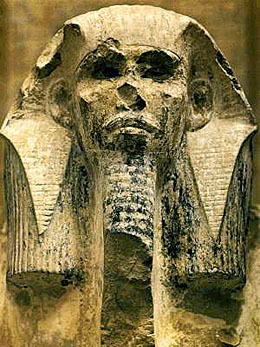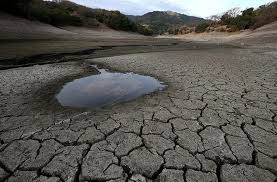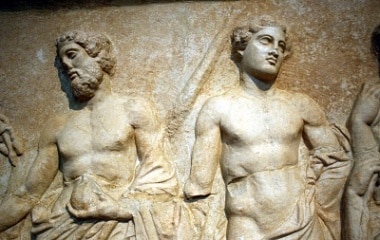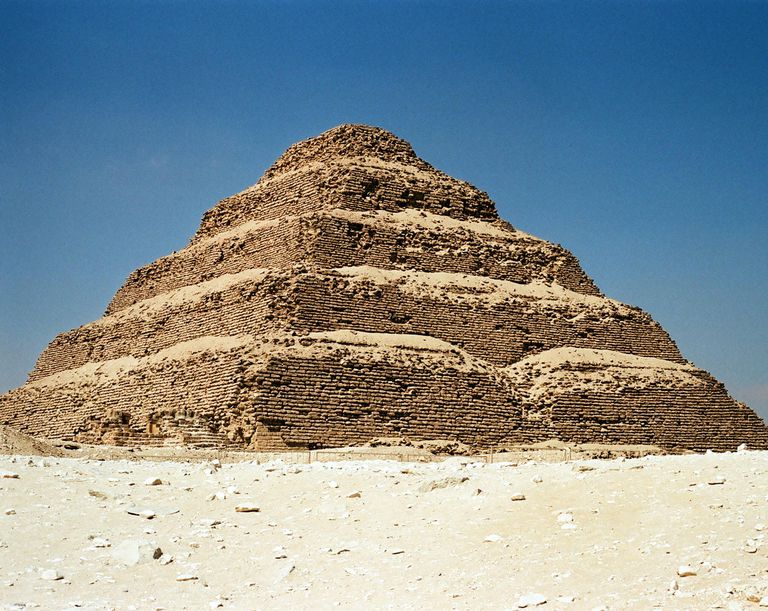The River Nile was the foundation upon which ancient Egyptian society stood, and as Egypt’s greatest resource, disruption in its flow was, alongside some others the foremost catalyst for the downfall of the chapter of ancient Egyptian history known as the “Old Kingdom” (c. 2686-2181 BC). Many view the Old Kingdom as the height of ancient Egyptian civilization, with the period producing some of Egypt’s most significant architectural and cultural advancements.
During the Old Kingdom’s sixth and final dynasty (c.2345-2181 BC), however, there began a decline. For decades, historians around the globe have theorised and puzzled over what led the Old Kingdom’s years of prosperity and advancement into the First Intermediate Period, a time of disorder and chaos that ran for approximately 120 years between the Old and Middle Kingdoms.
Nevertheless, we can be certain that Egypt’s Old Kingdom was not brought crumbling down by a single cause, but rather over time and by a combination of various factors, chief among which was likely the drying of the Nile, and that the consequences of this societal degradation echoed throughout the next century of Egyptian history.
There exist two rather significant misconceptions regarding the circumstances of the Old Kingdom’s fall: the first, that there was a spontaneous and total collapse, and the second, that there was a single contributing factor to this supposed collapse. It would be wise to immediately dispel such notions, as any kind of research into the subject of the Old Kingdom’s decline, shows clearly that neither did it occur instantly, and nor was it caused by a single factor.
Rather, the central government of ancient Egypt’s Old Kingdom eroded away over a number of years and as a result of a variety of factors, which led to the First Intermediate Period, during which there was extensive and chaotic civil war. Thomas Schneider, Professor of Egyptology at the University of British Columbia states, “We need to move away from this idea of collapse” (Lawler, 2015).
When discussing the nature of the Old Kingdom’s fall, it is important to consider how society was progressing in the Old Kingdom prior to its downfall and what occurrence initiated the chain of events that would lead to its eventual decline into the First Intermediate Period. The Old Kingdom is said to have begun with ancient Egypt’s third dynasty, and the first pharaoh to reign was King Djoser, a ruler also known for ordering his advisor, architect and high priest Imhotep to construct a stone step-pyramid in Saqqara now famously known as the Pyramid of Djoser.
As the Old Kingdom progressed, it reached a peak of prosperity and advancement with the fourth dynasty, during which the pharaoh Sneferu and his son, Khufu each built a number of pyramids. Sneferu constructed the Pyramids of Meidum and Dahsur, as well as the Bent Pyramid, and Khufu commissioned the Great Pyramid of Giza.
However, the fifth dynasty (c. 2494–2345 BC) signaled a beginning for the end of the Old Kingdom, as Userkaf, the first pharaoh of the fifth dynasty, began a series of reforms to weaken the control of the Pharaoh, and began to funnel resources into the growing Cult of Ra (Prakesh, 2019). This was followed by a number of events that, over many years, sapped Egypt’s political stability, and eventually led to the downfall of the Old Kingdom.

Over the fifth dynasty’s hundred and fifty years, many rulers came and went. Egypt continued to change with Userkaf’s vision echoing throughout the reigns of the next eight pharaohs as religion and the Cult of Ra took increasing importance in society. However, it was the sixth dynasty (c. 2345–2181 BC) of Egypt during which the Old Kingdom’s failure truly started.
Though it is generally accepted that the drying of the River Nile was the main stimulus that set-in motion the Old Kingdom’s decline, there are also a number of other possible reasons, most of which are related to politics and power feuding. Many scholars believe that the ninety-four-year rule of the Pepy II (the sixth dynasty’s fifth pharaoh) was a significant reason for the sixth dynasty’s downward spiral into the First Intermediate Period.
“The decline of the Old Kingdom begins with the reign of Pepy II.” (Müller-Wollermann, 2014). Pepy II outlived a number of his heirs, and thus, his extremely long rule created complications for succession within the royal family. Rivalries between the many possible inheritors of the throne caused chaos, threatening to totally deteriorate the rule of the reigning dynasty (Müller-Wollermann, 2014).
Moreover, Userkaf’s reforms had indeed succeeded, and by the time that Pepy II came into power, the pharaoh’s grip over Egypt had been severely weakened. At this time, the individuals around the pharaoh were growing increasingly powerful. For example, the growing importance of women is evidenced by the fact that by the end of the sixth dynasty, the tombs of Egyptian queens also had wall inscriptions, something reserved for pharaohs until then.
As the state’s interest in rural provinces grew, the power that was once held between the high-level officials at the capital spread through to local nomarchs in the countryside, and the centralized power of the pharaoh began to gradually weaken as it became stretched over the land. During the sixth dynasty, the tombs of nomarchs grew in size and sophistication, evidence that points to a weakening of central government as the high officials of the capital may have been acting on their own volition, outside the rule of the pharaoh.
Whilst the Nomarch’s increased independence lead to more government in rural areas and provinces, which aided in keeping stability during times of reduced flooding, it also caused in-fighting between Nomarchs and royalty. Renate Muller-Wollermann writes (2014), “…the decline of the Old Kingdom by a growing decentralization of the administration and economy that led to the weakness, and eventually collapse, of the central state”. The central government gradually began to crumble as it attempted to balance the efforts of maintaining power over the nomarchs from the capital and trying to exploit provincial resources.
It is widely considered that the increasingly erratic and eventually minimal flooding of the Nile River during the sixth dynasty was the final blow to the Old Kingdom, which led to an eventual decline into the First Intermediate Period. As the backbone of ancient Egyptian society, consistent and sizeable annual flooding by the Nile was highly important, as it provided fertile soil for agriculture, which produced wheat, a staple of ancient Egyptian food, and papyrus, an early form of paper made from reed fibers.
Furthermore, the Nile proved a highly lucrative and reliable trade route for the Egyptians, as it linked them with a number of countries throughout Africa and the Middle East. Thus, as the Nile’s annual flooding decreased, food shortages began and the Egyptians were forced to engage in increased trade to make up for the lost resources. Towards the end of the dynasty, lowered Nile flooding became a serious problem as famine slowly set in.
Professor Fekri Hassan has stated in an article for the BBC (2011) “This was so severe that famine gripped the country and paralysed the political institutions. People were forced to commit unheard of atrocities such as eating their own children”. Moreover, hieroglyphic inscriptions such as the Famine Stela at Sehel Island show deadly famines to have taken hold in Egypt as early as the third dynasty.
Additionally, modern-day scientific analysis of the Nile delta by Michael Krom of Leeds University indicates that there was a period of low Nile flooding shortly before the decline of the Old Kingdom (Mason, 2002). Clearly, the reduction of Nile flooding was something that erratically occurred throughout the entirety of the Old Kingdom and truly intensified towards its end and eventual decline into the First Intermediate Period.

As the Old Kingdom came to a close, the First Intermediate Period began. Egypt had been left in a disorderly and broken state following the Old Kingdom’s fall, and the First Intermediate Period followed suit, with chaotic civil war and famine. The First Intermediate Period is often described as ancient Egypt’s own “dark age”.
It spanned roughly three hundred years between the Old and Middle Kingdoms, and encompassed the seventh to the eleventh dynasties. Few monuments, inscriptions and temples have survived from this period, and thus we have little primary evidence about the time period.
The rule of Egypt was now fractured between two competing power bases at Heracleopolis and Thebes. It is thought that amid the ensuing chaos, numerous temples, artworks and monuments were destroyed or vandalized. The two kingdoms eventually came into direct conflict and the Thebans of the south conquered the north.
Thus, Egypt was reunified under a single Theban reign towards the end of the 11th dynasty. An inscription on the tomb of Ankhtifi, a monarch during the early years of the First Intermediate Period, describes the terrible state of the country when famine began. To summarize, the First Intermediate Period was indeed a dark time for Egypt, with many years of civil war, destruction and disorder.

In conclusion, one can concur that the Old Kingdom of ancient Egypt was brought down over a number of years and by multiple factors. These include the reduced flooding of the River Nile, extensive political feuding between royalty and the Nomarchs, and the excessively long rule of Pepy II, which caused unrest and rivalries within the royal house.
The combination of these factors eventually led to roughly 120 years of chaos, war, and destruction of temples and artifacts with what is known as the First Intermediate Period.
BIOGRAPHY
1. https://news.nationalgeographic.com/2015/12/151224-egypt-climate-change-old-kingdom-archaeology/
Lawler, A. (2019). Did Egypt’s Old Kingdom Die—or Simply Fade Away? [online] News.nationalgeographic.com. Available at: https://news.nationalgeographic.com/2015/12/151224-egypt-climate-change-old-kingdom-archaeology/
2.https://cloudfront.escholarship.org/dist/prd/content/qt2ns3652b/qt2ns3652b.pdf?t=plspm9&v=lg
Malek, J. (2019). BBC – History – Ancient History in depth: Primary Sources of the Old Kingdom.
Bbc.co.uk. Available at: http://www.bbc.co.uk/history/ancient/egyptians/primary_sources_01.
3. https://www.ancient.eu/Old_Kingdom_of_Egypt/
Mark, J. (2019). Old Kingdom of Egypt. [online] Ancient History Encyclopedia. Available at: https://www.ancient.eu/Old_Kingdom_of_Egypt/
4. http://www.bbc.co.uk/history/ancient/egyptians/primary_sources_01.shtml
Müller-Wollermann, R. (2019). End of the Old Kingdom. [online] Cloudfront.escholarship.org. Available at: https://cloudfront.escholarship.org/dist/prd/content/qt2ns3652b/qt2ns3652b.pdf?t=plspm9&v=lg
5. https://www.newscientist.com/article/mg17323271-800-how-egypt-was-felled-by-famine-in-2180-bc/
Mason, B. (2019). How Egypt was felled by famine – in 2180 BC. [online] New Scientist. Available at: https://www.newscientist.com/article/mg17323271.800-how-egypt-was-felled-by-famine–in-2180-bc.html/
6. https://www.metmuseum.org/toah/hd/oking/hd_oking.htm
Prakash, T. (2019). Egypt in the Old Kingdon. [online] Metmuseum.org. Available at: https://www.metmuseum.org/toah/hd/oking/hd_oking.htm
7. https://www.crf-usa.org/bill-of-rights-in-action/bria-25-1-what-caused-egypt-old-kingdom-to-collapse
Costly, A. (2019). BRIA 25 1 What Caused Egypt Old Kingdom to Collapse – Constitutional Rights Foundation.
Crf-usa.org. Available at: https://www.crf-usa.org/bill-of-rights-in-action/bria-25-1-what-caused-egypt-old-kingdom-to-collapse
8. https://www.history.com/topics/ancient-history/ancient-egypt#section_3
History.com. (2019). Ancient Egypt. [online] Available at: https://www.history.com/topics/ancient-history/ancient-egypt#section_3
9. https://www.cemml.colostate.edu/cultural/09476/egypt02-03enl.html
Cemml.colostate.edu. (2019). Egypt: Old Kingdom and First Intermedia Period (2700-2055 BC). [online] Available at: https://www.cemml.colostate.edu/cultural/09476/egypt02-03enl.html
10. http://www.bbc.co.uk/history/ancient/egyptians/apocalypse_egypt_01.shtml
Hassan, F. (2019). BBC – History – Ancient History in depth: The Fall of the Egyptian Old Kingdom.
Bbc.co.uk. Available at: http://www.bbc.co.uk/history/ancient/egyptians/apocalypse_egypt_01.shtml
11. https://www.ancient.eu/First_Intermediate_Period_of_Egypt/
Mark, J. (2019). First Intermediate Period of Egypt. [online] Ancient History Encyclopedia. Available at: https://www.ancient.eu/First_Intermediate_Period_of_Egypt/

